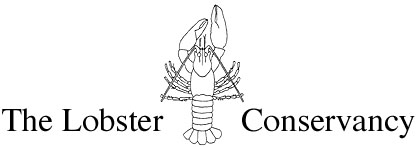
P.O. Box 235, Friendship, ME 04547 (207) 832-8224 www.lobsters.org

P.O. Box 235, Friendship, ME 04547 (207) 832-8224 www.lobsters.org
August 25, 2000
Dear Volunteers and Friends of The Lobster Conservancy,
For those of you who may be unfamiliar with The Lobster Conservancy, our purpose is to ensure healthy populations of the American lobster (Homarus americanus) and preserve the traditional trap fishery that depends on this resource. We are primarily a scientific research organization. This newsletter keeps our volunteer research team informed of our activities.Research News
Volunteer Program
The fourth month of Baby Lobster Watch 2000 was very busy. There were signs of newly-settled lobsters entering the population throughout the range of our survey, including sites in Penobscot Bay, Casco Bay, and Massachusetts Bay. Volunteers who are going back into the field at the end of the month should be sure keep your eyes peeled for tiny lobsters.
In Penobscot Bay, high school student Kipp Quinby found evidence of recent settlement on Isle au Haut, with lobsters as small as 11 mm in carapace length (CL) (8 lobsters, 11-41 CL). On Matinicus Island, Eva, Eric and Emily Murray showed Jill and George Tarkleson and Abby Sears how to sample and found 4 lobsters (36-64 mm CL). At Waterman Beach Alfred Petterson, Leslie Fuller, Nancy Light, Chris Fichtel, Tim Dwyer, Annette Naegel and Linda Cartwright found 13 lobsters that measured between 30 and 64 mm CL, some of which were found sampling randomly. On Vinalhaven, John and Ginger Van Ness found 8 lobsters (24-56 mm CL) in rocky intertidal habitat and another 6 (39-72 mm CL) in eel grass beds. One disturbing story is that the fears of Jane Roundy and Julie Wortman were realized, in that vandalism in July appears to have seriously decreased their lobster count at Drift Inn Beach. They found only 2 lobsters in early August, whereas they often find 20 or more.
In Muscongus Bay, Mike Wall single-handedly discovered 20 juvenile lobsters ranging in size from 31-70 mm carapace length, before he was chased away by the incoming tide. (For more on Muscongus Bay, see Friendship Long Island, below.)
In Eastern Casco Bay Corie Bibber Logan found 6 lobsters (13-42 mm CL) in Mackerel Cove and Pat Masonheimer helped her find another 10 lobsters (5-33 mm CL) at Little Harbor. The little 5 mm lobster was clear evidence of new settlement; it was so small that it was still phototactic. Good eyes, ladies! Chris Heinig took Sara Ellis to his sampling site at Gun Point. Together they found 23 lobsters (6-58 mm CL). (For more on Eastern Casco Bay, see Lowell's Cove, below.)
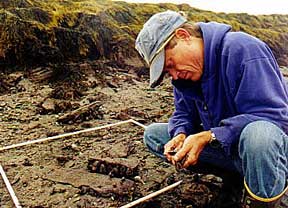
Harpswell volunteer Chris Heinig measuring a lobster at his long-term monitoring site at Gun Point. Photo by Sara Ellis
In Western Casco Bay, Helen Muther along with Mike Doan, Meaghan Murphy and Alida Payson of Friends of Casco Bay found a whopping 30 lobsters (27-52 mm CL)! On Chebeague Island, Mac Passano, Beth Howe, Erno Bonebakker and Carol White went back to Bennett's Cove where they found several lobsters.
In Southern Maine, Enid White and Patrice Farrey were foiled by a tide that did not go as low as predicted, which meant that their transect was not very exposed. Nonetheless they did find several juveniles at Lobster Cove in York (3 lobsters, 26-31 mm CL).
In New Hampshire, Al Stewart trained Carol Spinney in the fine art of lobster sampling at Odiorne Point State Park. Timothea Jousse and Julie Ligon were there that day and did random sampling while Al and Carol concentrated on the regular transect. Altogether they found 12 lobsters (22-49 mm CL). Michele Swisher, Jean Willcox and Mary-Louise Knopp scouted out Concord Point in Rye, a.k.a. Stinky Beach, but there were no lobsters to be found. The team will be scouting for a new site in Rye later this month. In New Castle, "Jumbo" Jervis and John and Carolyn Payzant ferreted out 14 lobsters (20-64 mm CL).
In Massachusetts, Oddvar Solstad and Sean Sullivan continued to find high densities of lobsters in Marblehead, including settlers. This time they found 33 juveniles (11-48 mm CL). In Gloucester, Astrid and Carson af Klinteberg and Pat Earle were assisted by Salem Sound 2000 interns Susie O’Connell and Deb Ginter. They measured 24 lobsters (23-51 mm CL) and noted that 3 feisty ones got away. Chad Keith and Heather Sagar found only 1 lobster again (30 mm CL) at Manomet Point, making it clear that this site is not a productive nursery ground, so they plan to search for a new site next time around.
Long-term Tagging of Juvenile Lobsters
On Friendship Long Island, our tagging program is progressing well, with several tagged lobsters being recaptured each sampling session. This month Diane and Sara were joined by Sabrina Sturman of the Bay of Fundy Marine Resource Centre, who plans to start an intertidal lobster monitoring program in Nova Scotia with local lobstermen. Other onlookers included Jocelyn Vigneault of Nova Scotia and Marcella Bombardieri of the Boston Globe. Marcella shadowed Diane in the field and back at the Lobster Life Study Center for more than 12 hours before writing a great article for the Globe (www.lobsters.org/press/press.php).
At Lowell's Cove, Polly Wilson and Anne Barrett helped Diane cover three transects. Sabrina Sturman of Nova Scotia recorded data as part of her training process. They found several newly-settled lobsters measuring only 6 mm in carapace length.
Sea Sampling
Diane has started up a sea-sampling program, in which she is going out on lobster boats to sample what comes up in the catch. The project has begun in Wheeler Bay, which opens into Penobscot Bay, with long-time lobsterman Alvin Rackliff. Data that are being collected include the same data that volunteers record on juvenile lobsters (e.g., length, sex, and distinguishing characteristics), as well as additional information related to sexual maturity and status of adults (e.g. numbers of egg-bearing females, width of the female’s abdomen, and size of the male’s crusher claw). Stay tuned!
Lobster Health and Reproductive Condition
On August 17 Professor Joseph Kunkel of the University of Massachusetts, Amherst made his second visit to Friendship to continue studying the health and reproductive condition of captive lobsters. Joe and Diane bled and tagged more lobsters and recorded their condition. This work will be on-going.
Lobster Life Study Center
We would like to thank the Friendship Planning Board for accepting our application to establish the Lobster Life Study Center at the Friendship Lobster Pound. This acceptance formally recognizes the change in usage of the pounds from commercial fisheries to non-commercial fisheries.
The month of August brought many visitors out to Friendship Long Island, many of whom pitched in to help with ongoing tasks. Tim Pickering brought out granddaughter Sarah, before she headed off to Audubon camp. Laura Hinkley and Meghan Frend helped transport rocks for lobster shelters and scraped pesky barnacles off the dam. Sarah and Carolyn West gathered rocks and entered data, and donated a viewing bucket for observing organisms underwater. Venca Borst of England has been helping with data entry during her island sojourn. Arilda and Dan Densch shuttled rocks around the pound at high tide to areas where lobster shelters need to be built. Thank you to all.
Outreach and Education
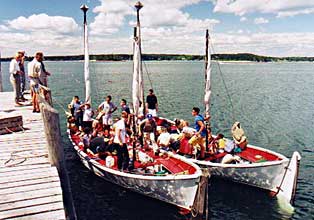 Teenagers participating in a course at Hurricane Island Outward Bound School rowed up to TLC's wharf in two pulling boats. Photo by Sara Ellis |
||||||
 In exchange, students insulated the basement of our Lobster Life Study Center. Photo by Sara Ellis |
||||||
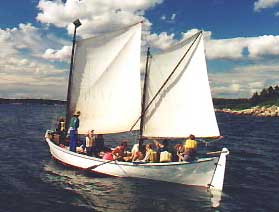 Once the service-learning project was complete, the team from Hurricane Island Outward Bound School sailed off to further adventures. Photo by Sara Ellis. |
||||||
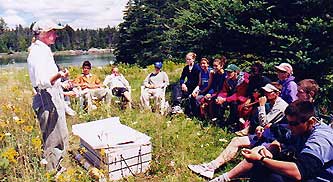 Diane taught students about lobster biology, fisheries, and research in TLC's scenic outdoor classroom. Photo by Sara Ellis |
||||||
The Lobster Conservancy hosted a marine touch tank on Friendship Day, featuring organisms captured by high school students Sarah and Tom Arnold of Nobleboro. We had many stoppers-by, both young and old, who enjoyed seeing marine critters up close and personal, as well as the juvenile lobster that was on display. But the star of the show was a gynandromorph lobster (half male, half female) that was kindly donated by Friendship lobsterman, Gerry Lane. Thank you to the Fishermen’s Heritage Lobster Co-op for contributing male and female lobsters, and to Merle and Jean Beale for lending us a wading pool.

High school student Sarah Arnold (center) and her brother Tom (not shown) helped TLC host a Touch Tank on Friendship Day. Photo by Sara Ellis
News of The Lobster Conservancy spread far and wide this month. The Lobster Life Study Center was featured in two newspaper articles: "Scientist Gets up Close with State’s Top Crustacean" by Dan Dunkle of the Courier Gazette, and "Lobster Shift" by Marcella Bombardieri of the Boston Globe. The latter article was later picked up by other New England newspapers, including the Providence Journal. News of the volunteer program made it into the Marblehead Reporter ("Counting on Lobsters" by TLC volunteer Sean Sullivan) and the Salem Evening News ("Lobster count helps predict future harvests" by Sue Ellen Woodcock). An article on new-shell versus hard-shell lobsters ("Shell Game" by Robert Emro in Foster’s Sunday Citizen) quoted information from TLC’s web page and scientists. These articles will all be posted on the press page of our web site (www.lobsters.org/press/press.php), so surf on in when you get a chance.
Recent Events
On August 12, TLC’s Board of Directors met at the Lobster Life Study Center to chart TLC’s course. Our 5-hour meeting was punctuated by a delicious lunch prepared by Friendship foodie Patricia Seward.

The Lobster Conservancy thanked volunteers for their many hours of service with a lobster feast on Friendship Long Island. Photo by John Payzant
August 19 marked Volunteer Appreciation Day, when TLC volunteers from Maine, New Hampshire and Massachusetts gathered for a day of recognition of their important contributions to The Lobster Conservancy. The weather gods cooperated that day, allowing us to thank volunteers in style, with great appetizers and salads prepared by Patricia Seward, and lobsters, corn and potatoes cooked up by New Hampshire volunteer Al Stewart. As if that wasn’t enough, volunteers also brought along yummy desserts. We unveiled TLC’s new T-shirt, designed by Steve Alexander of Steve’s Signs, and printed by ProForma Premier Printing. T-shirts were given to volunteers as tokens of our appreciation, and will be available to non-volunteers for $10 each. We wish to thank Shaw’s of Rockland, Beth’s Farm Market of Union, and Shop ‘n Save of Damariscotta, Waldoboro and Rockland for donating food and papers goods. Special thanks go to Randy Lee of Genthner’s wharf in Friendship and board member Carl Anderson for contributing lobsters.
Upcoming Events
Diane and Sara have been selected to give oral presentations at the 6th International Lobster Conference and Workshop on Lobster Biology and Management, which will be held in Key West, September 10-15. The titles of their talks are giving "Multiple mark and recapture studies of free-ranging juvenile American lobster, Homarus americanus" and "Volunteer-based monitoring of intertidal nursery grounds of American lobster, Homarus americanus." TLC board member Kari Lavalli, a professor at the University of Southwest Texas, is also giving a presentation on "Group defense in Caribbean spiny lobsters, Panulirus argus."
End Notes
We end with fond farewells and thanks to volunteers Sarah and Tom Arnold, high school students who spend their summers in Nobleboro. Best wishes for the school year back home in Goshen Connecticut. Good-bye and thanks also to Island Institute intern Tim Dwyer who helped out TLC with data entry and worked at the Lobster Life Study Center this summer. We wish Tim well in his new teaching stint at the Catalina Island Marine Institute in California.
Yours in TLC and Friendship,
Sara Ellis, Executive Director and Diane Cowan, Senior Scientist